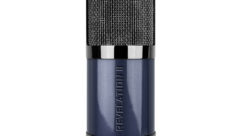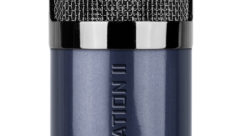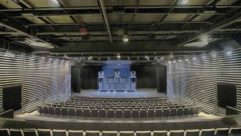Versatility with Intimacy
Apr 1, 1998 12:00 PM,
Jack McLean
The facility is part of a more than 64,000 ft squared (5,946 meter squared)addition to the church, located in Kentwood, MI, which is just south ofGrand Rapids. The expansion effort included a rehearsal suite thataccommodates 150 musicians, a library, nurseries, a bookstore, welcomecenter and Community Hall, a cathedral-type facility adjacent to theCelebration Center that hosts weddings, banquets and other special events.
The Celebration Center’s structure, aesthetics and technical elements havebeen carefully blended to create an inviting, comfortable facility. Formand function combine, meeting a lengthy list of challenging criteria, andit is exemplary of the changing nature of houses of worship, where, forinstance, a sanctuary is used for more than Sunday morning services.
On Saturday nights, the center hosts Nightlife services, which featurecontemporary rock performances, and Sundays offer traditional services. Inbetween are dramatic performances, concerts, ballet and meetings of variouschurch and community groups. The room may be in use several times each dayin a wide range of applications.
“The Celebration Center has been envisioned to meet a number of priorities,which takes compromise because each time you select a priority, you changethe design,” explains Bryce D. Beckett, director of media ministry atKentwood Community Church. “There had to be a realization that you can’t doeverything absolutely perfectly, but you can do it all very well. Thisbecame our guidepost for the project.”
An architectural firm was selected, Goss Pasma Barker Architects ofEvanston, IL, following a proposal process in which they showed acommitment to work as a flexible partner with the church in developing thenew facility. One notable stipulation was that the church would hire itsown acoustical, lighting and video consultants.
Beckett, working in tandem with a church committee assembled to support hisefforts, then turned his focus to interviewing a number of qualifiedacoustical consultants. He traveled to meet with the firms personally andtoured some of their most recent projects for further insight. Out of thisresearch, Acoustic Dimensions was asked to contribute. Beckett had beenparticularly impressed with a multichannel sound design the company hadrecently completed for the Zaragosa Theater at the Fiesta Texas theme parkin San Antonio. He also felt that Acoustic Dimensions displayed the perfectattitude, which was a commitment to do the project correctly, respectingthe client’s goals and ideas while also willing to express strong opinions.
Ancha Electronics of Chicago was selected to provide sound systeminstallation and design engineering support. Bill Gillette managed thisfacet, and Max Culver from the Chicago area was tapped to consult onlighting and theatrical issues.
Acoustic Dimensions also handled video projection screen layout andconfiguration. Most significantly, however, they were charged with guidingand coordinating the efforts of all technical vendors, as well as workingclosely with the architect to guide the design of the facility to maximizeits functionality, effectiveness and comfort.
A community environment”The Celebration Center, as a sanctuary design, is a prototype. It’s notreally based on any other type of design,” Beckett said.
At the top of the priority scale was fostering a feeling of community amongthe congregation, encouraging them to sing and participate fully inservices. An acoustical cone or reflector design throughout the ceiling,created by Acoustic Dimensions, aids in establishing an intimate sonicenvironment. The cones provide early reflections to the audience, andconversely, they also offer a superior environment for vocal performers,whether solo or ensemble artists, rock, ballad or traditional. Moreover,the choir needs few mics because they can naturally project throughout theroom.
Acoustics are further optimized by a non-focusing back wall, which iscovered by absorptive panels, thereby reducing the potential for reflectingenergy back to the stage, and assisted further by padded theater-styleseats and carpet throughout the room. The furthest seats in the2,317-capacity room, located in the balcony, are only 108 feet (33 m) fromthe main pulpit. Side walls are only 140 feet (43 m) apart at their widestseparation.
“It’s a mixture of theater and church styles in the way the room is setup,” noted Craig Janssen, principal of Acoustic Dimensions. “The designteam selected the most effective elements of both styles and integratedthem to great effect.”
In aesthetics, sightlines and functionality, the center resembles aperforming arts center. A 26′ x 56′ (8 m x 17 m) proscenium, flanked bymasonry arches with oak panels, frames a thrust stage that accommodates a100-member chorus, 40-piece orchestra, two grand pianos and an organ whilestill affording sufficient room for spoken-word presentations. Thisextended stage is supported by an 1,800 ft squared (167 meter squared)backstage with a full-height fly tower for supporting major productions.
Sightlines were paramount in terms of viewing both the stage/pulpit as wellas three large-format video screens that were flown in the prosceniumopening. Approximately 98 percent of all seats have a direct view of thescreens, which, incidentally, can be removed when not needed.
“We’ve been using video in our worship for seven years and have found thatit’s always most effective when the screens are centered,” Beckettexplains. “When they’re placed to the sides, it tends to draw focus awayfrom the stage. The goal is for video to enhance what’s happening and notto be a distraction.”
High production valuesDavid Kahn and Nick Edwards of Acoustic Dimensions spearheaded earlyacoustical and room design efforts, later followed up by Eric Seifert, whofollowed it through construction. Part of this focus was not strictly uponacoustics, but issues of general noise control, particularly that of theHVAC system, which were carefully controlled.
“The room, inherently, needed to be fairly live while simultaneouslyoffering a contemporary stage performance format,” Janssen says. “Acousticswere dealt with more by shaping than by putting in elaborate acoustictreatments. The sound system needed loudspeakers with good pattern controlto keep energy from reflecting off surfaces.
The high production values of the church, combined with Beckett’s review atFiesta Texas, led to a left/center/right (LCR) design for the house soundsystem. Janssen focused first upon the loudspeaker segment beforecompleting the entire system design. Dale Alexander handled the exhaustivedocumentation process and supported programming efforts with thesophisticated digital signal processing system.
The clusters flown at the front of the room comprise Eastern Acoustic Works(EAW) loudspeakers, used by Janssen frequently in high-end designs,including the one at Fiesta Texas. Left and right clusters include twolevels. At the top of each are two EAW MH662E mid/high loudspeakers thatprovide longer throw to cover balcony seating and the furthest main floorseats. They flank two EAW TD415 low-frequency loudspeakers with two EAWMH660Es underneath for coverage of the remainder of floor seating, pickingup where the longer-throw loudspeakers leave off.
The TD415s use a patented concept developed by Janssen called tuned dipolararray. Through a combination of specialized placement of the loudspeaker’stwo 15 inch (381 mm) as well as two 12 inch (305 mm) woofers, a uniquecabinet design and specialized signal processing, the TD415 delivers a highdegree of low-frequency directivity in the vertical plane. This issignificant in performance situations, where one of the primary goals is tokeep noise off the stage in order to enhance gain before feedback andreduce reverberant field excitation.
The center cluster has three levels, with the top consisting of a singleTD415 above three MH662Es for longer throw. At the bottom are two EAWMH690iEs, also a mid/high loudspeaker but with a wider coverage patternthan the MH660E/662E.
“The effectiveness of the MH and TD combination for high-performanceapplications can’t be overlooked,” Janssen noted. “The two elements workvery well together to produce high intelligibility and musical fidelitythat’s tightly controlled through the entire passband. Also, these twotypes of loudspeakers package well together. Using standard ATM flyware,they can be rigged and flown easily and aimed precisely.”
Coverage to seats in the very front rows is bolstered by EAW UB22loudspeakers built into the stage lip. Added low-end punch is supplied byfour EAW SB215 subwoofers located at ground level under the front of thestage. Shadowed areas under the balcony receive further reinforcement viaEAW LC8CX2XO coaxial ceiling loudspeakers on time delay in reference to themain system.
“Acoustic Dimensions recommended EAW loudspeakers, and we were quiteinclined to agree, based on the overall quality of the product and thereputation of the company,” Beckett adds.
Sophisticated processingThe room’s fairly wide scope, coupled with the stage’s thrusting deeplyinto the room, dictated wide coverage angles from the loudspeakers. In thedesired LCR format, this presented significant challenges.
“By flying the clusters at points to the front of the downstage lip, thecenter cluster ended up being considerably forward of the left and rightclusters because of the stage’s thrust,” Janssen explains. “In fact, thecenter was about 10 feet (3 m) further out than the others. Therefore, itwasn’t possible for the left cluster to supply coverage to the right sideof the room, and vice versa.
“One of the precepts of the design, however, is that each component, be itleft, center or right, must cover the entire room so that there isstability in the mix,” he continued. “The idea is that when you pan toleft, center or right, it doesn’t matter where you might be in the room. Ifthe mix balance doesn’t change, the aural perspective of where sound isoriginating changes. In other words, the imaging changes, but the balancedoesn’t.”
As a result, this unique project dictated some fairly sophisticatedcross-matrixing done via the Peavey MediaMatrix digital signal processingsystem. MediaMatrix is a mainframe incorporating DSP cards that provide allprocessing tools required, including delay, crossover and EQ, and it isavailable in a myriad of choices and in multiples. With MediaMatrix, everycluster has its own 3 x 5 matrix mixer with outputs to each of itsrespective loudspeakers.
The cross-matrixing strategy employed for the Celebration Center canperhaps best be explained by considering, for example, the left cluster,which covers about 60 percent of the room. When sound is intended to bepredominantly from this cluster, a delay is cross-matrixed from the leftfeed to both the center cluster’s long-throw loudspeakers covering theright side of the room, as well as to the outside-right loudspeakers of theright cluster. Therefore, if sound is panned hard left, it is appropriatelydelayed with respect to the left cluster, with some sound coming fromcenter and right clusters. Because of this balance, listeners in the centerand right sides of the room still perceive sound to be generated by theleft cluster rather than the cluster closest to them.
“Essentially we’re able to matrix in any proportion and with delay, any orall of the three inputs (left, center or right) to any of the components ofany given cluster,” Janssen says. “It’s a rather complete matrixing schemewith more than 30 delay zones.”
Each loudspeaker is outfitted with its own EQ and crossover for furthertailoring and complete tonal integration. Passive crossovers are usedbecause the MH Series has well-matched sensitivity in transition from midsto highs. By going passive, power efficiency is increased, significantlyreducing total output power needed by each cluster.
Remaining elementsLoudspeakers are driven by Crown Macro-Tech power amps located in a securedroom above back stage. Macro-Tech MA3600VZ power amps drive both thesubwoofers and TD415 loudspeakers, while MA-2400 power amps handle theMH662 loudspeakers and MA-1200 power amps power the MH660 loudspeakers. Thesix front fill loudspeakers are powered by MA-600 power amps, while a CrownCom-Tech amp with a 70 V transformer handles the underbalcony ceilingloudspeakers.
At the house mix position, located at the front/center of the balcony, aCybex keyboard/mouse extender and monitor supply remote control of theMediaMatrix mainframe, which is stored with the power amps. Passwordprotection prevents unauthorized access to the mainframe and its variety ofsystem presets, established to allow quick, convenient configuration of thesystem for a number of common uses or modes.
The 52-input Crest VX console was selected because of its LCR panningcapability. ADC patch panels supply plenty of routing flexibility. Sourcedevices include Denon CD, Nakamichi cassette and Sony DAT players, withmics from the stage split to a tape recording facility where mixdown isperformed via an additional console. Eight monitor mixes are available onstage.
TeamworkProgress continues on several technical aspects of the Kentwood ChurchCelebration Center, to be completed when time and budget allow. Followinginitial commissioning of the sound-reinforcement system, an evaluationprocess revealed a few minor changes that have subsequently been made,further optimizing overall performance. While work is ongoing, all partieshave expressed their satisfaction with results to this point.
“Both acoustically and from a sound reinforcement and video standpoint, thechallenge was to take a room that is strongly presentational and instill asense of intimacy for the congregation, with worship portions still clearlyaudible,” said Janssen. “Through the careful preparation of the team, wherethe commitment was to work together to achieve things as well as possible,much progress has been made. It’s important to point out the wisdom of thechurch in creating and fostering this successful environment.”
Beckett concurred, noting, “It was awesome the way that the team worked.The attitude was, ‘Let’s not say that it won’t work, but instead, let’sfocus on making it all work together.’ The first service, when we could seehow it had all come together, was truly inspirational.”










